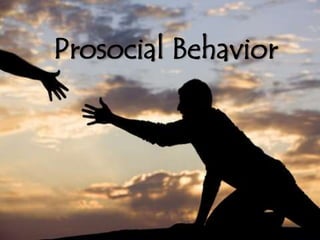Prosocial behavior
•Als PPTX, PDF herunterladen•
7 gefällt mir•7,108 views
Presentation about prosocial behavior (social psychology)
Melden
Teilen
Melden
Teilen

Empfohlen
Empfohlen
Weitere ähnliche Inhalte
Was ist angesagt?
Was ist angesagt? (20)
Defeating the Bystander Effect - How to Act as a Good Samaritan During Emerge...

Defeating the Bystander Effect - How to Act as a Good Samaritan During Emerge...
Ähnlich wie Prosocial behavior
Ähnlich wie Prosocial behavior (20)
nadeemspresentation-150614095304-lva1-app6892.pptx

nadeemspresentation-150614095304-lva1-app6892.pptx
lecture-9-prosocial-behaviour-1192604828567351-4.pptx

lecture-9-prosocial-behaviour-1192604828567351-4.pptx
Community Engagement Forum 2020: Establishing Meaningful Relationships with C...

Community Engagement Forum 2020: Establishing Meaningful Relationships with C...
Kürzlich hochgeladen
This presentation was provided by William Mattingly of the Smithsonian Institution, during the fourth segment of the NISO training series "AI & Prompt Design." Session Four: Structured Data and Assistants, was held on April 25, 2024.Mattingly "AI & Prompt Design: Structured Data, Assistants, & RAG"

Mattingly "AI & Prompt Design: Structured Data, Assistants, & RAG"National Information Standards Organization (NISO)
God is a creative God Gen 1:1. All that He created was “good”, could also be translated “beautiful”. God created man in His own image Gen 1:27. Maths helps us discover the beauty that God has created in His world and, in turn, create beautiful designs to serve and enrich the lives of others.
Explore beautiful and ugly buildings. Mathematics helps us create beautiful d...

Explore beautiful and ugly buildings. Mathematics helps us create beautiful d...christianmathematics
Kürzlich hochgeladen (20)
Disha NEET Physics Guide for classes 11 and 12.pdf

Disha NEET Physics Guide for classes 11 and 12.pdf
Measures of Central Tendency: Mean, Median and Mode

Measures of Central Tendency: Mean, Median and Mode
Mattingly "AI & Prompt Design: Structured Data, Assistants, & RAG"

Mattingly "AI & Prompt Design: Structured Data, Assistants, & RAG"
A Critique of the Proposed National Education Policy Reform

A Critique of the Proposed National Education Policy Reform
social pharmacy d-pharm 1st year by Pragati K. Mahajan

social pharmacy d-pharm 1st year by Pragati K. Mahajan
Russian Escort Service in Delhi 11k Hotel Foreigner Russian Call Girls in Delhi

Russian Escort Service in Delhi 11k Hotel Foreigner Russian Call Girls in Delhi
Interactive Powerpoint_How to Master effective communication

Interactive Powerpoint_How to Master effective communication
Explore beautiful and ugly buildings. Mathematics helps us create beautiful d...

Explore beautiful and ugly buildings. Mathematics helps us create beautiful d...
Ecosystem Interactions Class Discussion Presentation in Blue Green Lined Styl...

Ecosystem Interactions Class Discussion Presentation in Blue Green Lined Styl...
Z Score,T Score, Percential Rank and Box Plot Graph

Z Score,T Score, Percential Rank and Box Plot Graph
Call Girls in Dwarka Mor Delhi Contact Us 9654467111

Call Girls in Dwarka Mor Delhi Contact Us 9654467111
Web & Social Media Analytics Previous Year Question Paper.pdf

Web & Social Media Analytics Previous Year Question Paper.pdf
Prosocial behavior
- 2. What is Prosocial Behavior? “Voluntary actions that are intended to help or benefit another individual or group of individuals" (Eisenberg and Mussen 1989). Any act performed with the goal of benefiting another person. (e.g. helping, comforting, sharing) Characterized by a concern about the rights, feelings and welfare of other people.
- 3. Prosocial behavior vs. Altruism Prosocial behavior refers to a pattern of activity, whereas, altruism is the motivation to help others out of pure regard for their needs rather than how the action will benefit oneself.
- 4. BASIC MOTIVES UNDERLYING PROSOCIAL BEHAVIOR: WHY DO PEOPLE HELP? 1. Social Exchange Theory: The Costs and Rewards of Helping The theory that human interactions are transactions that aim to maximize one’s rewards and minimize one’s costs. Presumes that people help only when the rewards outweigh the costs.
- 5. 2. Social Norms: • According to this principle, people are likely to help strangers if it is understood that the recipient is expected to return the favor at some time in future. a. Reciprocity norm • States that we should help when others are in need and dependent on us. b. Social-Responsibility norm • Women not only receive more offers of help in certain situations but also seek more help. c. Gender and receiving help norm
- 6. Evolutionary Psychology Any social behavior that enhances reproductive success (the conception, birth, and survival of offspring) will continue to be passed on from one generation to the next. a. Kin selection • The idea that evolution has selected altruism toward one’s close relatives to enhance the survival of mutually shared genes.
- 7. SITUATIONAL DETERMINANTS OF PROSOCIAL BEHAVIOR: WHEN WILL PEOPLE HELP? A. Environment: Rural versus Urban • People in rural areas are more helpful. B. Residential Mobility • People who have lived in one place for a long time are more likely to engage in prosocial behaviors. C. The Number of Bystanders: The Bystander Effect • Refers to the tendency for people to become less likely to assist a person in distress when there are a number of other people also present.
- 8. Reasons for the “Bystander Effect” • Three main hypotheses: – Pluralistic ignorance • We look to others to see how to act – Social inhibition • We don’t want to draw negative attention to ourselves – Diffusion of responsibility • The burden of helping is shared with others
- 9. How can we increase helping? A. Increasing the Likelihood that Bystanders Will Intervene B. Enable guilt and concern for self-image C. Socializing altruism
